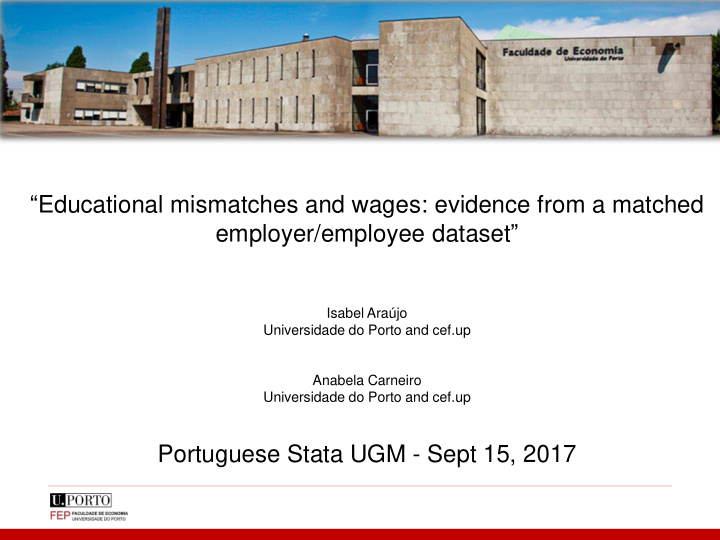



“ Educational mismatches and wages: evidence from a matched employer/employee dataset ” Isabel Araújo Universidade do Porto and cef.up Anabela Carneiro Universidade do Porto and cef.up Portuguese Stata UGM - Sept 15, 2017
Road Map Motivation Previous Literature Methodology and Data Results
Skills mismatch in the labor market Matter of great concern; ▪ Arise from several imbalances between the skills offered ▪ and the skills demanded in the labor market due to: Information asymmetries; ▪ Transaction costs; ▪ Unresponsive education and training systems to the world of work. ▪ Inefficiencies in the utilization of labor; • Detrimental effects on productivity and growth. •
Why does it matter? Overinvestment on college education? US - 1970’s: boom in the supply of graduates (Freeman, ▪ 1976); In recent years: ▪ Topic of concern in European Countries; • Huge massification of higher education enhanced by the • Bologna process.
Previous Literature There is a growing body of literature that aims to study: ▪ ➢ The effects of overeducation on wages and other labor market outcomes ( Duncan and Hoffman, 1981; Hartog and Groeneveld, 2004; Kiker, Santos and Oliveira, 1997; Verdugo and Verdugo, 1989 )
In this paper: ▪ Educational mismatches among the employed and their effects on wages. ▪ Rich matched employer/employee dataset ▪ Vertical mismatches in the Portuguese labor market over the period 1995-2012 ▪ Main goal: investigate to what extent job-mismatched workers suffer a penalty on wages when compared with similar well job- matched workers.
Data: Quadros de Pessoal (QP) a large longitudinal linked employer-employee administrative dataset collected by the Portuguese Ministry of Employment. QP covers virtually all firms operating in the Portuguese private sector and employing at least one wage earner. Available information: at the firm level includes employment, sales, industry, ownership, location, among others. at the individual-level , QP reports information on each worker’s age, education, gender, qualifications, wages, occupation, tenure, number of hours worked, and type of contract. All firms, establishments, and workers are identified with a unique identification number, so they can be matched and followed over time.
How to define educational mismatch? The criteria used to define: educational mismatch among the employed is crucial to our analysis previous literature showed that the patterns of skills mismatch strongly depend on the criteria adopted to measure mismatches (ILO, 2014).
How to define educational mismatch? To identify vertical mismatches: - statistical measures based on realized matches - objective method: Job Analysis Definition: A vertical mismatch occurs when the level of education/qualification is higher or lower than the one required for the job. This definition is the most commonly used in the literature that studies the impact of overeducation on wages (e. g., Duncan and Hoffman, 1981; Verdugo and Verdugo, 1989; Oliveira et al., 2000; Hartog and Groeneveld, 2004; Korpi and Tahlin, 2009).
Required education (RE): Realized matches RE: defined as the mean or mode level education: for all workers in a three-digit occupation or newly hired workers (tenure less than 12 months); Then, required education for a given occupation is compared to the actual level of schooling attained by the worker in that same occupation in order to classify the individuals as over or under educated (e. g., Kiker et al., 1997).
Required education (RE): Job Analysis ISCO-base approach following the Job Analysis P UBLIC A DMINISTRATION , WORKERS FROM ARMED FORCES AND AGRICULTURE ARE EXCLUDED FROM OUR DATASET .
Required education (RE): Job Analysis Workers having the required education for the job are those whose years of schooling in a major group at 1-digit level are as follows: major group 1: 15 years of schooling; major group 2: 16 years of schooling; major group 3: 15 years of schooling; major groups 4, 5, 6, 7 and 8: 9 years of schooling major group 9: 4 years of schooling. Workers having more or less years of schooling than this required education are considered overeducated or undereducated, respectively.
Incidence of Over and Undereducation in Portugal, 1995-2012 more than 50% of the Portuguese workers in the private sector suffer from an educational job-mismatch
Regression Analysis Based on these indicators of the individual’s educational mismatch status, we will estimate a Mincerian wage equation that controls for workers observed and unobserved heterogeneity, firm and job title observed characteristics.
OLS Results: Duncan and Hoffman (ORU model), Portugal 1995-2012 ▪ When compared with their co-workers who are adequately educated, overeducated workers receive a wage bonus for the extra years of schooling and undereducated workers a wage penalty for the extra years of deficit education. ▪ However, the additional returns to a year of overeducation are lower than the returns to required education.
OLS results: Verdugo and Verdugo model, Portugal 1995-2012 Overeducated workers earn less and undereducated workers earn more, than ▪ similar workers with the same years of schooling, but who hold jobs for which they are adequately educated. These results are, in general, in accordance with previous related literature.
Fixed-effects results (full sample): Duncan and Hoffman (ORU model), Portugal 1995-2012 The fixed-effects results indicate that taking into account workers unobserved (permanent) heterogeneity reduces considerably the discrepancy between the wages of well job-matched workers and job mismatched workers, evince that failure to control for individual unobserved heterogeneity may overestimate the impact of over- and undereducation on earnings.
Fixed-effects results (full sample): Verdugo and Verdugo model, Portugal 1995-2012 Note: FE estimates of the returns to overeducation and undereducation are identified only from persons who have changed their educational level or job level.
Thank you!
Recommend
More recommend